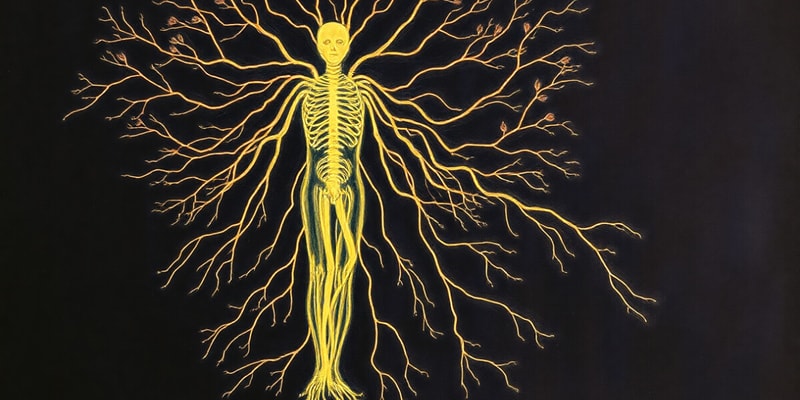Podcast Beta
Questions and Answers
What are the three essential roles of the nervous system?
Which component is part of the Central Nervous System?
How does the nervous system primarily communicate signals?
Which organ system works alongside the nervous system to coordinate bodily functions?
Signup and view all the answers
Which cells are considered the building blocks of the nervous system?
Signup and view all the answers
What is the primary function of neuroglia in the nervous system?
Signup and view all the answers
Which cells form myelin sheaths in the peripheral nervous system?
Signup and view all the answers
What is the primary role of the blood-brain barrier?
Signup and view all the answers
Which statement accurately describes sensory neurons?
Signup and view all the answers
What type of tumor is a glioma?
Signup and view all the answers
What is the primary function of the myelin sheath?
Signup and view all the answers
What occurs at the nodes of Ranvier?
Signup and view all the answers
What part of the neuron is primarily responsible for receiving signals from other neurons?
Signup and view all the answers
What is the consequence of the myelin sheath deteriorating in multiple sclerosis?
Signup and view all the answers
Which statement accurately describes unmyelinated nerve fibers?
Signup and view all the answers
What is one of the common symptoms associated with neurological conditions?
Signup and view all the answers
What causes vesicles to fuse with the plasma membrane during synaptic transmission?
Signup and view all the answers
What is the role of a neurotransmitter in synaptic transmission?
Signup and view all the answers
Which process occurs after the neurotransmitter binds to receptors on the postsynaptic membrane?
Signup and view all the answers
What is one of the initial steps that happens when an action potential reaches a synaptic knob?
Signup and view all the answers
Study Notes
Homeostasis and Nervous System Overview
- Homeostasis is the balance maintained by organ systems working cooperatively.
- The nervous system comprises the brain, spinal cord, and nerves, continuously receiving internal and external signals.
- Two major systems coordinate cellular activities: the endocrine system (hormones) and the nervous system (electrical signals).
Essential Roles of the Nervous System
- Sensing: Uses sense organs and nerve endings to detect internal and external changes.
- Integrating: Processes information, correlates with past experiences, and decides appropriate responses.
- Responding: Sends commands to muscles and glands to elicit changes based on processed information.
Divisions of the Nervous System
- Central Nervous System (CNS): Encompasses the brain and spinal cord.
- Peripheral Nervous System (PNS): Comprises a vast network of nerves throughout the body.
Nervous System Cells
- Two main types of cells are present: Neurons (communicate signals) and Neuroglia (support and protect neurons).
Neuroglia
- Also known as glial cells, meaning "glue," serve as supportive cells in the nervous system.
Cell Types
-
CNS Neuroglia:
- Oligodendrocytes form myelin sheaths, enhancing signal conduction.
-
PNS Neuroglia:
- Schwann cells create myelin sheaths around peripheral nerves, forming the neurilemma.
Blood-Brain Barrier (BBB)
- Formed by astrocytes and endothelial cells, it acts as a semi-permeable membrane.
- Allows small molecules to pass but blocks larger ones, protecting the brain from foreign substances.
- Complicates treatment for brain disorders due to limited access for medications.
Neurons
- Nerve cells responsible for communication within the nervous system.
Classes of Neurons
- Sensory Neurons (Afferent): Detect stimuli (touch, pressure, heat, chemical changes) and relay information to the CNS.
Neuron Structure
-
Comprises three main parts:
- Cell Body (Soma): Central control, contains the nucleus.
- Dendrites: Receive signals and conduct information to the soma.
- Axon: Transmits nerve signals away from the soma; typically has only one axon.
-
Myelin Sheath: Lipid-rich insulation around axons, facilitating rapid impulse conduction.
-
Nodes of Ranvier: Gaps in the myelin sheath that enhance signal transmission.
-
Synaptic Knob: Branches at the axon terminal where neurotransmitter release occurs.
-
Myelination begins in the fetal stage and is not complete until late adolescence.
Life Lesson: Multiple Sclerosis
- MS involves deterioration of myelin sheaths in the CNS, replaced by scar tissue (plaques).
Common Symptoms of MS
- Visual disturbances (blindness/double vision).
- Weakness and loss of coordination.
- Speech difficulties.
Synaptic Transmission Process
- Action potential triggers synaptic activity.
- Membrane depolarization allows calcium ions to enter.
- Calcium facilitates vesicle fusion and neurotransmitter release into the synapse.
- Neurotransmitter binds to receptors on the postsynaptic membrane, influencing continuation (excitation) or cessation (inhibition) of the impulse.
- Released neurotransmitters are reabsorbed by synaptic knobs after receptor binding.
Studying That Suits You
Use AI to generate personalized quizzes and flashcards to suit your learning preferences.
Description
Explore the fascinating functions of the nervous system in this quiz. Understand how it works in conjunction with the endocrine system to maintain homeostasis in the body. Test your knowledge on the structure and communications of these vital organ systems.



